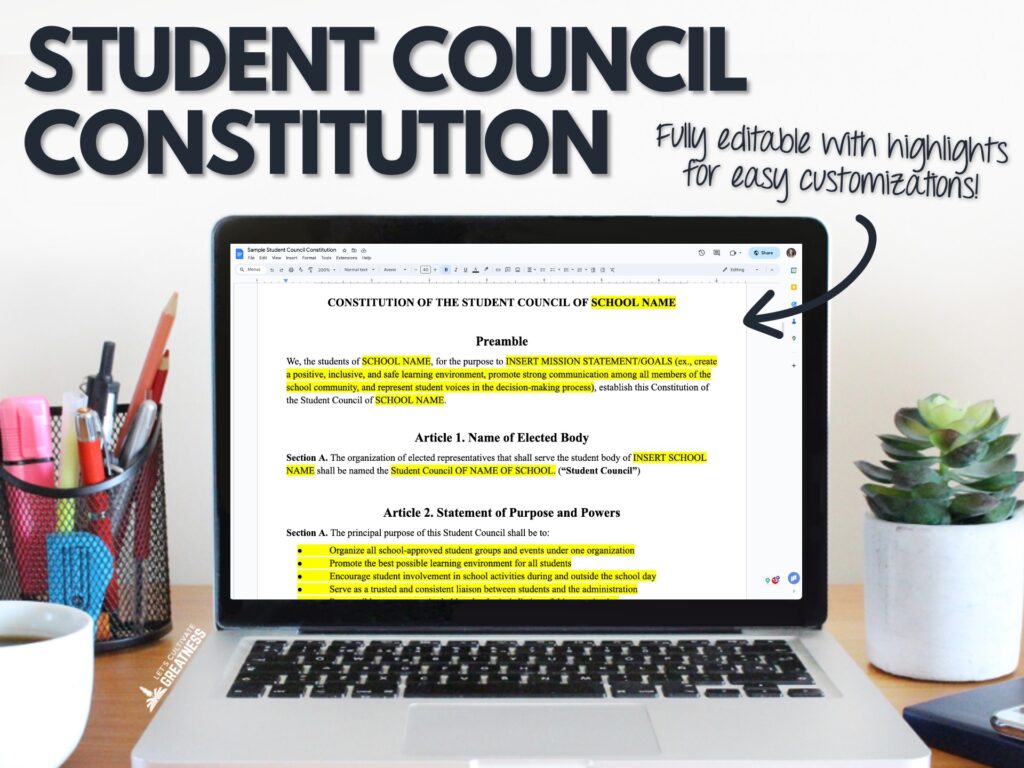Drafting your constitution is one of the first must-do tasks of creating a student council. You absolutely need one.
If your council already exists but doesn’t have one, or the existing one is severely lacking, clear the calendar to write it. A constitution is what makes the work the council does legitimate.
It also helps you mitigate crises because your constitution gives you clear language on addressing situations like removing an officer or dealing with a micro-managing principal. It makes your job as an advisor so much easier!
So, send out an all-call for staff and students to join a committee to create or revise your constitution. To further give legitimacy to your constitution, it cannot be made behind closed doors.
Below, I include several of my best tips for creating a strong constitution from the start so that sticky situations can be handled easily and your council members understand their responsibilities.
Also check out my sample student council constitution template to get you started, which includes all sorts of embedded suggestions and marked spots for easy customizations.
What is a student council constitution?
Officially, the constitution belongs to the whole student body, of which the council is their representative governing group. And just like a nation’s constitution, it’s a written document that establishes the basic outline for how the council—your school’s government—will work.
A constitution includes fundamental things like how elections will happen, how vacancies will be handled, and what officer positions will make up the council.
Specific details, like exact days for elections and officer GPA requirements, don’t belong in a constitution. They are better suited to put in your bylaws or to decide and post in your role as the advisor.
A constitution should be written in simple, clear language to avoid grey areas or confusion.
What should be in a student council constitution?
Your constitution will have several parts, called articles. Each article covers a different topic. Here are the most essential articles I recommend having to start.
- Official name and a statement of purpose for the constitution and council
- Officer titles and basic eligibility requirements
- Duties and powers of each officer position
- Frequency and procedures for how the council meets and votes
- When and how elections will held
- Steps for removing officers and filling vacancies
- How future amendments will be handled
- Ratification procedures
How to Write a Student Council Constitution
Now, let’s talk about how to create your constitution. No matter what, it will be a big undertaking, so there needs to be a lead person, likely you, the advisor, and a generous timeline of a few months to get several rounds of input.
Form a Constitution Committee
Gather your current officers, if you have them, then open your committee to any interested students and staff at your school. This ensures the group has a wide range of perspectives and reflects the whole student body.
Keep this core group manageable (5-10) with a larger group (15-20) available for a round or two of feedback.
Also, invite your principal and finance secretary to be part of the process. The more adult eyes on the document, the better!
Consult Legal Advice & Other Constitutions
Connect early on with your district office and state student council association regarding any legal requirements for your student body constitution. They may have guidance, a template they want you to follow, or require you to include certain items. They may also need to review the final draft before ratification.
Also, connect with nearby schools’ advisors to see their constitutions and get their advice.
One of your first steps will be to spread out half a dozen examples from other schools to see what they have in common, how they’re organized and worded, and what things you’ll want to avoid or include.
I suggest doing some of this work ahead of your first formal meeting.
Decide Core Values & Mission Statement
While the goals of student councils are generally the same, your students will feel ownership if they select values unique to your school setting. Using those words and ideas, draft a preamble. Think of it like an enduring mission statement at the beginning of your constitution. This will help the rest of the decision-making remain focused.
You’ll likely end up revising your preamble as you build your constitution. That’s totally normal! So don’t get caught up too much in the exact wording to start. A solid first draft is a stronger guiding light than not having one at all.
Keep the Exact Details Out of Your Constitution
Like I mentioned above, constitutions are meant to outline only the most fundamental requirements, powers, and procedures for an organization to function.
Resist the temptation to include exact rules or specifics that aren’t necessary. For example, only state that candidates should “remain in good academic standing” and leave it to your Officer Code of Conduct or your bylaws to list a specific GPA requirement.
Or state that elections will be held in the month of April, not “the third Friday in April.”
Allow for Student Input & Revisions
Meet with that larger body of students beyond your core committee a few times to brainstorm core values and the preamble, and then to get feedback on your early and final drafts.
If possible, also share your final draft with the whole student body for the last round of feedback. Post the file online, create a Google form to gather feedback, and set a deadline of one week.
Create a Ratification Process
Lastly, allow a window of time for the whole student body to view the final full text of the constitution and hold a ratification vote.
Afterward, host a celebration to acknowledge the formal start of your student government. This can be as simple as a special presentation at lunchtime, during the next assembly, or over the intercom.
Preserve & Distribute Your Constitution
Find several places to digitally store both an editable and non-editable version of your final, ratified constitution. An editable version should only be available to you, the advisor, and your admin and secretarial team for backup.
As for the secured, non-editable version, post it on your school’s website and include it in the folder you share with your officers. I also like to include paper copies in each of my officers’ binders and a few communal copies to have on hand during meetings or in my classroom.September is National Library Card Sign-up Month, so host a friendly class competition for how many students already have or signed up for a local public library card. Invite your local librarians to set up a sign-up table one day during lunch.
I hope these tips have given you a good starting point for drafting your constitution. Grab my fully editable Student Council Constitution template, complete with “plug-in-here” customizations, to get your program started even faster and easier!

Image credit: Jewsin Thomas









